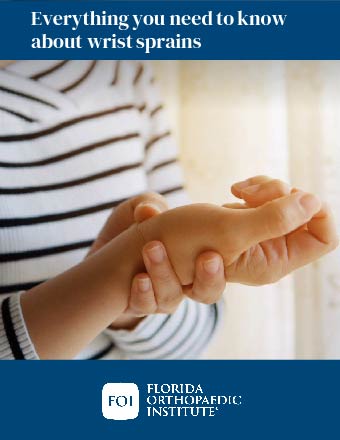Sprained wrist
Sprains in the wrist are very common injuries that can happen to individuals of any age. They can be caused by falling onto an outstretched hand or accidentally bending the wrist forcefully. Most wrist sprains usually respond well to basic, home care (nonsurgical) treatments. In severe cases, surgery may be needed.
Anatomy
Sprains take place when soft tissues known as ligaments are hurt. A sprain in the wrist refers to stress on a ligament. Ligaments are strong bands of connective tissue that hold the bones together. They can stretch and extend within a normal range of movement. Ligaments in the wrist can be sprained if unusual stress is put on them, like overstretching or experiencing a sudden force. If a ligament is stretched or torn, you may need treatment to get your full wrist mobility back.
About wrist sprains
A sprain in the wrist is typically caused by falls or accidental movement in sports activities. An unusual amount of pressure on the wrist, such as a fall on an outstretched hand, can sprain the wrist.
Sprains can range in severity and are graded based on how bad they are. Much like other ligament tears such as ankle sprains, wrist sprains are graded on a scale of 1 to 3:
- Grade 1 – The mildest sprain. It occurs when ligaments are unusually stretched but not torn. This mainly occurs in accidental everyday movement.
- Grade 2 – Moderate sprains that occur when the ligaments are partially torn. It is not uncommon to have some loss of function with this grade of sprain.
- Grade 3 – The most severe sprain occurs when ligaments are completely torn. Grade 3 wrist sprains need immediate medical care, as the ligament may have taken a chip of bone with it when it tore (an avulsion fracture). These sprains usually need surgical care.
Causes and risk factors
In many instances, sprains in the wrist occur following a sudden event like a fall in which the person in question lands on their wrist. This type of sprain can also result from unexpected forceful contact to the wrist during sporting competitions or car accidents.
An individual’s risk of experiencing this injury can increase if they participate in contact sports such as football, boxing, wrestling, and basketball. Additionally, skiers and gymnasts are at elevated risk since they use their hands to grip gear like poles and bars forcefully. The intense pressure placed on their wrists leaves them more prone to injury.

Symptoms
Symptoms of a sprained wrist vary depending on the severity. The most common symptoms include:
- Swelling in the wrist
- Amount of pain at the time of the sprain
- Persistent pain when the injured wrist is bent or moved
- Bruising and discoloration of the skin around the damaged wrist
- Wrist tenderness
- A “popping” feeling inside the wrist
- A warm or fever-like feeling to the skin around the wrist
It is important to note that not all serious injuries lead to noticeable symptoms. Individuals with higher pain thresholds may feel that their injury is mild if they do not see any swelling, but even that could still be a ligament tear requiring a surgical procedure.
Sprained wrists might sometimes cause symptoms commonly produced by other potentially serious injuries like fractures. If not identified and treated as soon as possible, fractures may not heal correctly and eventually need surgery to repair them correctly. An unrecognized fracture (occult fracture) is sometimes mistaken as a sprained wrist.
It is recommended in all but very mild cases that if you feel you have sprained your wrist, you should make an appointment with one of our skilled wrist and hand specialists at Florida Orthopaedic Institute for diagnosis.

Diagnosis
Diagnosis usually requires several stages.
Your physician will ask about your symptoms and medical history during a physical examination. They will ask questions such as when the pain started, if you recently took a fall or were involved in a car accident, if you play any contact sports, and if the pain is worsened when performing any movements or activities. They will also ask about any hand or wrist injuries you may have had in the past.
Your physician will examine your arm and hand to ensure that you have not broken any bones. They will ask about numbness in the hand or tenderness in certain areas. Partial ligament tears are sometimes hard to diagnose but can become chronic disabilities if left untreated.
Should the first two steps not be enough to help reach a conclusion, your physician may order imaging tests such as x-rays to determine whether your wrist is sprained and to what grade it could be sprained. Although x-rays do not show an injury to a ligament, they can show whether there have also been any broken bones because of the sprain.
A magnetic resonance imaging (MRI) scan, computed tomography (CT) scan, or arthrogram may be ordered in severe cases. An MR arthrogram is used to make the joint and ligaments show up more clearly from a dye injected into the joint.
Treatment
Fortunately, most sprained wrists respond well to home care. Your treatment will depend on factors such as age, the grade of sprain, general health, level of physical activity, and if there are any other related injuries or broken bones. Most wrist sprains can be treated at home and healed within a few weeks.
Nonsurgical treatments
The Florida Orthopaedic Institute’s philosophy is first to try all appropriate nonsurgical methods to increase mobility and function.
Mild sprains in the wrist can be treated at home via the R.I.C.E. (Rest, Ice, Compress, Elevate) protocol:
- R – Rest the joint for at least 48 hours. Rest means limiting all unnecessary movements.
- I – Ice the injury to reduce swelling. Ice should be applied to the injured wrist every 20 to 30 minutes over a several-hour period in the days following the injury. The cold produced by ice helps bring down swelling and lessen discomfort. Ice should never be applied directly to the skin as it can lead to frostbite and other complications. Ice cubes or ice packs should be placed inside a towel and firmly wrapped.
- C – Compress the swelling with an elastic bandage. The hurt wrist should be compressed using items such as specialized bandages, splints, or casts. This protects the damaged wrist and keeps it from moving unnecessarily.
- E – Elevate the injury above the level of the heart. This decreases blood flow to the damaged wrist so that it reduces swelling and improves blood circulation to the injured area so healing can occur at a faster rate.
Over-the-counter medicines such as aspirin or ibuprofen (Motrin, Advil) may help with pain and swelling. If these symptoms persist, contact your physician.
More moderate sprains may need to be immobilized with a wrist splint for at least one week. It is important to keep your wrist in the splint and listen to your physician’s instructions to avoid further damage. Your physician may also request that you perform some stretching exercises to gradually regain full movement in the wrist or undergo physical therapy designed to prevent the wrist from weakening or losing its range of motion.
Surgical treatments
In the most severe cases, sprained wrists may need surgery. Your Florida Orthopaedic Institute physician will discuss your surgical options. For a fully torn ligament, the surgical procedure involves connecting the ligament back to the bone that it tore away from during the injury.
Post-surgery rehabilitation exercises are gradually introduced to strengthen the wrist and improve mobility. The expected healing time from surgery is anywhere from 6-8 weeks, although this period varies by individual. Patients need physical therapy to regain strength and mobility following the operation.
Recovery
Individuals with mild or moderate injuries usually make a full recovery in several weeks to a month or so. The average healing time following surgery ranges from six to eight weeks, depending on the severity of the sprain and the extent of the operation. It may take several months to regain prior wrist movement completely.
Complete recovery of the wrist’s movement depends on the severity of the sprain but can take several months.

Learn everything you need to know about wrist sprains in our comprehensive guide.
Related specialties
- Basal Joint Surgery
- Carpal Tunnel Syndrome
- De Quervain's Tenosynovitis
- Dislocated Finger
- Distal Radius Fracture (Broken Wrist)
- Dupuytren’s Disease
- Flexor Tendonitis
- Fractured Fingers
- Functional Nerve Transfers of the Hand
- Ganglion Cysts
- Hand & Finger Replantation
- Hand Nerve Decompression
- Hand Skin Grafts
- Nerve Pain
- Peripheral Nerve Surgery (Hand) Revision
- Revascularization of the Hand
- Rheumatoid Arthritis of the Hand
- Sports Wrist & Hand Injuries
- Sudden Acute Finger, Hand & Wrist Injuries
- Targeted Muscle Reinnervation (TMR)
- Tendon Transfers of the Hand
- Thumb Ulnar Collateral Ligament Injuries
- Trigger Finger
- Ulnar Neuritis
- WALANT (Wide Awake Local Anesthesia No Tourniquet)
- Wrist Arthroscopy
- Wrist Fractures
- Wrist Tendonitis
